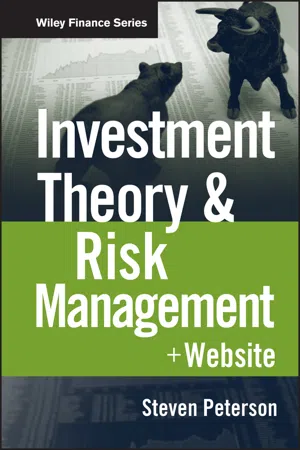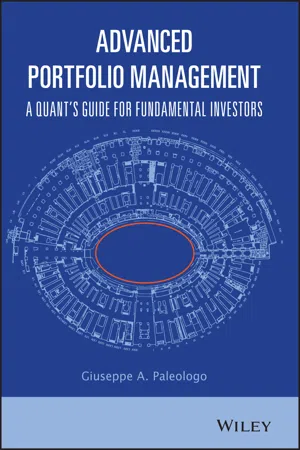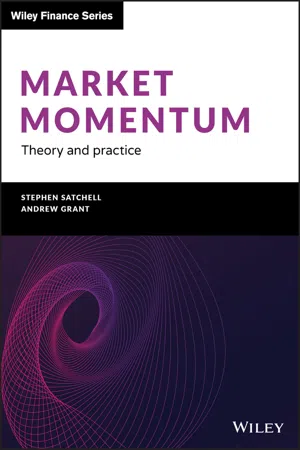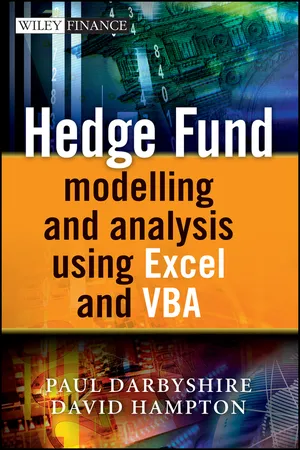Fama French 3 Factor Model
The Fama French 3 Factor Model is an asset pricing model that expands on the Capital Asset Pricing Model (CAPM) by incorporating additional factors: size and value. It suggests that the returns of a portfolio can be explained by exposure to market risk, size risk (small vs. large companies), and value risk (high book-to-market ratio vs. low). This model is widely used in finance to analyze and predict stock returns.
7 Key excerpts on "Fama French 3 Factor Model"
- eBook - ePub
- Steven Peterson(Author)
- 2012(Publication Date)
- Wiley(Publisher)
...Chapter 9 Factor Models An economist is someone who sees something in the real world and wonders if it would work in theory. —Ronald Reagan The CAPM can be interpreted as a single index factor model, and since we are already familiar with it, I will use the CAPM to introduce this important class of pricing models. Factor models can be thought of as models of the conditional mean return to an asset (or portfolio of assets). We used unconditional mean return estimates as inputs to the optimal mean-variance efficient portfolios solved for in Chapters 6 and 7. To understand the difference, let r it be the return on asset i at time t. Then the asset's unconditional mean return is simply the average return, that is, E (r i) =. Now, think of the CAPM model: For ease of exposition, drop the risk-free rate (that is, assume that cash earns no return) and take expectations (see the statistical review in the appendix to Chapter 5) noting that E (ε i) = 0 by definition. Then, Simply stated, this says that the expected return is now conditional on the market return. The market return is therefore the single factor and beta is the return (sometimes called the factor loading) to that factor. There are several attractive features of factor models that are developed in this chapter, but the first and most obvious feature is that factors help attribute the asset's return to movements in specific underlying sources of risk and return. The Fama-French three-factor model introduced in Chapter 8, for example, decomposes the asset's return into three component parts—the return attributable to the value portfolio (HML), the return attributable to market capitalization or size (SMB), and the market return: Since the factors themselves are returns, then the factor returns (the betas) measure the return attributable to the asset's exposure to each of these factors. Thus, a 1 percent change in the factor is expected to move the asset's return by the amount of its beta with respect to that factor...
- eBook - ePub
The Handbook of Equity Market Anomalies
Translating Market Inefficiencies into Effective Investment Strategies
- Leonard Zacks, Leonard Zacks(Authors)
- 2011(Publication Date)
- Wiley(Publisher)
...Jointly, the size and value anomalies were considered by Fama and French (1992) who argued that the cross-sectional variation in stock returns is completely captured by size and BE/ME, but not by market beta, leverage, or the E/P ratio. Fama-French Three-Factor Model The Fama-French risk model was developed as an extension of the CAPM that can explain the value and size anomalies. In a seminal paper, Fama and French (1993) suggest two new risk factors: the difference in returns on portfolios with high book-to-market and low book-to-market ratios (HML) and the difference in returns on portfolios with small stocks and large stocks (SMB). They show that the size premium and the value premium can be considered as a compensation for risk related to these new factors. In this sense, the Fama-French model provides a risk-based explanation for the anomalies and claims that the abnormal returns for small and value stocks are associated with high betas of these stocks with respect to the HML and SMB factors. Value Anomaly: Risk or Mispricing? The interpretation of HML and SMB as risk factors has stimulated an active discussion whether higher returns on value stocks and small stocks indeed represent a compensation for risk (i.e., are related to stock betas) or should be attributed to mispricing caused by various investors’ behavioral biases (i.e., are associated with the stock characteristics). There are a number of possible psychological reasons why investors might overvalue growth stocks and undervalue value stocks. First, investors may give too much weight to past performance; in general, growth stocks have high historical growth. It is possible that investors project past performance too far into the future, overvaluing growth stocks and undervaluing value stocks. Second, it is possible that investors choose to invest in good companies regardless of whether those companies are fairly priced, that is, they overpay for growth...
- eBook - ePub
- (Author)
- 2021(Publication Date)
- Wiley(Publisher)
...1995. “The Three Types of Factor Models: A Comparison of Their Explanatory Power.” Financial Analysts Journal 51 (3): 42–46. Dopfel, Frederick E. 2004. “Fixed-Income Style Analysis and Optimal Manager Structure.” Journal of Fixed Income 14 (2): 32–43. Fabozzi, Frank J. 2008. Handbook of Finance, Financial Markets and Instruments. Wiley. Fama, Eugene F., and Kenneth R. French. 1992. “The Cross-Section of Expected Stock Returns.” Journal of Finance 47 (2): 427–65. Grinold, Richard, and Ronald N. Kahn. 1994. “Multi-Factor Models for Portfolio Risk.” In A Practitioner’s Guide to Factor Models. Charlottesville, VA: Research Foundation of the Institute of Chartered Financial Analysts. Podkaminer, Eugene L. 2017. “Smart Beta Is the Gateway Drug to Risk Factor Investing.” Journal of Portfolio Management 43 (5): 130–34. Ross, S. A. 1976. “The Arbitrage Theory of Capital Asset Pricing.” Journal of Economic Theory 13 (3): 341–60. Practice Problems © 2017 CFA Institute. All rights reserved. Compare the assumptions of the arbitrage pricing theory (APT) with those of the capital asset pricing model (CAPM). Last year the return on Harry Company stock was 5 percent...
- (Author)
- 2019(Publication Date)
- Wiley(Publisher)
...(The term “anomaly” in this context refers to an observed capital market regularity that is not explained by, or contradicts, a theory of asset pricing.) From the perspective of the CAPM, there are size, value, and momentum anomalies. From the perspective of the Carhart model, however, size, value, and momentum represent systematic risk factors; exposure to them is expected to be compensated in the marketplace in the form of differences in mean return. Size, value, and momentum are common themes in equity portfolio construction, and all three factors continue to have robust uses in active management risk decomposition and return attribution. 4. Multifactor Models: Types Having introduced the APT, it is appropriate to examine the diversity of multifactor models in current use. In the following sections, we explain the basic principles of multifactor models and discuss various types of models and their application. We also expand on the APT, which relates the expected return of investments to their risk with respect to a set of factors. 4.1. Factors and Types of Multifactor Models Many varieties of multifactor models have been proposed and researched. We can categorize most of them into three main groups according to the type of factor used: In a macroeconomic factor model, the factors are surprises in macroeconomic variables that significantly explain returns. In the example of equities, the factors can be understood as affecting either the expected future cash flows of companies or the interest rate used to discount these cash flows back to the present. Among macroeconomic factors that have been used are interest rates, inflation risk, business cycle risk, and credit spreads. In a fundamental factor model, the factors are attributes of stocks or companies that are important in explaining cross-sectional differences in stock prices...
- eBook - ePub
Advanced Portfolio Management
A Quant's Guide for Fundamental Investors
- Giuseppe A. Paleologo(Author)
- 2021(Publication Date)
- Wiley(Publisher)
...Chapter 4 An Introduction to Multi-Factor Models What will you learn here: What are multi-factor risk models; how many different types of models are there; and how are they estimated? Most importantly, how do they allow you to separate two worlds: the world of factors from that of company-specific returns? Why does this matter: Because it is the skeleton that supports the whole thing. Even if you do not see it, it is there and it is essential. When will you need this: Always and never. Always, because you will consume its byproduct daily; (almost) never, because you won't have to think about “factor portfolios”, or cross-sectional regressions unless you really miss them. 4.1 From One Factor to Many We have seen that alphas do not come from straightforward regressions. What about betas? Is the market beta the beta to end all betas? It turns out that this is just the beginning of the story. The single-beta factor model was proposed independently by Lintner and Mossin, and Sharpe, who gave it the now-standard name Capital Asset Pricing Model (CAPM), in the mid-1960s. It was immediately put to the test. Initial empirical studies confirmed the model [Black et al., 1972 ; Fama and MacBeth, 1973 ]. In the mid-1970s, three separate contributions by young researchers set the stage for a second revolution. First, Stephen Ross, then an assistant professor at Yale, extended the CAPM. His starting point is to assume that there is a small number of factors, compared to the number of assets, which act on the returns, not unlike the CAPM. Compare Figure 4.1 to Figure 3.2. (4.1) The betas in the Eq. (4.1) are termed loadings of a specific stock to a factor; this term is borrowed from the statistics literature on factor models. That same year, Barr Rosenberg (then an associate professor at Berkeley) and Vinay Marathe [Rosenberg and Marathe, 1976 ] proposed that loadings be characteristics of a stock...
- eBook - ePub
Market Momentum
Theory and Practice
- Stephen Satchell, Andrew Grant(Authors)
- 2020(Publication Date)
- Wiley(Publisher)
...We next discuss some academic research in which sorting has been identified as pertinent. Lambert and Hübner (2014) present a critique of the sorting methods of Fama-French, arguing that the value premium may be mis-specified, and is driven by the sorting rather than as compensation for risk. They prefer a procedure that is based on conditioning arguments, which leads to alternative estimates of risk premia. The key change in the context of this chapter is the replacement of independent sorting with sequential sorting. Cremers et al. (2012) discuss differences between practitioner-oriented studies (that primarily use broad index-based benchmarks) and academic studies (that prefer to use Fama-French factor model benchmarks). For instance, Cremers et al. (2012) examine the return to the S&P500 index (a common benchmark for mutual funds) against a Carhart four-factor benchmark, and find a positive and significant annual alpha of 0.82% p.a. for the period 1980 to 2005. They attribute this finding to three sources. Firstly, in the size/book-to-market independent sorts in the Fama-French data set, portfolios are equally weighted when constructing SMB and HML factors. This overweights small stocks relative to a market capitalization-weighted index. Secondly, the market index is proxied by the CRSP value-weighted index, which includes assets outside the universe of US Common stocks (such as Real Estate Investment Trusts [REITs] and American Depositary Receipts [ADRs]), which have underperformed the S&P500. Cremers et al. (2012) also suggest that index rebalancing effects of broad stock indices exacerbate return differences compared with the CRSP index. The main finding of the Cremers et al. (2012) study is that by using appropriate weighting schemes (value weighting stocks within portfolios) and investable benchmarks, out-of-sample tracking error volatility is reduced substantially...
- Paul Darbyshire, David Hampton(Authors)
- 2012(Publication Date)
- Wiley(Publisher)
...They remain a reasonably valid method for explaining the increased returns experienced by investing in long value and short growth stocks, long small cap and short large cap (the difference reflects largely taking higher credit risks with the small cap companies, hence it reflects additional risk premia earned from endogenous risk factors). Momentum measures the abnormal returns borne from holding long certain stocks within a stock market basket and shorting others depending on their recent performance. Table 6.6 Subgroup 3: Fama–French–Carhart factors No. Abbreviation Factor 9 Val – Gr Value minus Growth 10 SC – LC Small Cap minus Large Cap 11 Mom Momentum Subgroup 4 (Table 6.7) is representative of alternative beta indices which are either available commercially or which could be replicated in-house using a transparent systematic trading approach, e.g. a trend-following scheme applied to futures markets. Four indices are proposed which cover the main financial markets within the managed futures/CTA industry, namely stock indices, bonds, commodities and foreign exchange. The question now is: how do they fit in to our assessment of hedge fund performance? To start to answer this question, the available factor set is best visualised in terms of a beta continuum (Anson, 2008) versus hedge fund fees, as shown in Figure 6.3. It could be argued that alpha is in fact a cleverly disguised complex alternative beta and so could in theory be replicated. According to hedge fund managers, however, they have unique proprietary trading algorithms, pricing models and skill which allow them to generate alpha. Up to the last decade or so, most investors did not have the analysis tools available to find out who was bluffing whom...






